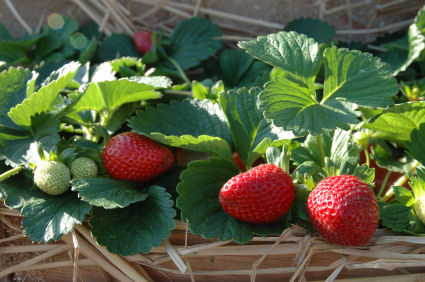Strawberry Season
|
June bearing strawberries ripen in late spring with a large crop over about a three-week period.
Ever bearing strawberries produce a crop in spring and one in fall.
Day neutral strawberries produce fruit throughout most of the growing season.
|

Varieties we carry:
Earliglow is the earliest strawberry on the market. The deep red fruit is uniform in shape and color. It has a wonderful strawberry flavor and is considered one the best flavored strawberries. Disease resistant.
Allstar is a June bearing strawberry that is superior in flavor and size. It is highly productive. An excellent home garden selection, the berry has an almost perfect shape and is a glossy, firm fruit. Disease resistant.
Albion is a new variety from California and is day neutral. This strawberry is known for its very large fruit . The fruit is mostly conical, very firm and red in color. Its flavor is sweet and pleasant. It is a high yielding cultivar with robust stalks and runners. The high sugar content makes this the perfect dessert fruit. Disease resistant
|
PLANTING
Plant your strawberries in full sun in well-drained sandy loam that is slightly acidic. Do not plant where tomatoes, pepper, eggplants, or potatoes have been grown recently because of the risk of Verticillium Rot.
When preparing your strawberry bed, a soil test will determine whether you need to add lime and fertilizer and how much of each. If you will till or rake your bed several times over a two-week period before planting, you will help to eliminate freshly germinated weeds. This will prevent them from being a problem in your bed after your plants are in. A rich organic soil is best. Apply 10-10-10 fertilizer when planting at a rate of 1 pound per 100 sq. ft.
June bearing strawberries send out a lot of runners, so plant them in double rows 24 inches apart, with the double rows being 4-4 ½ feet apart. Plants should be set 18 inches apart. This will form a mat for the runners to make more plants.
Day neutral and ever-bearing strawberries do well planted in hills 8 inches high and 2 feet wide. Stagger the plants in double rows about 12 inches apart in the hill. These strawberries don’t send out many runners, but the runners that do appear should be removed along with flowers until July 1st of the first year. The plants can then be allowed to produce. This will help the production for next year.
Mulch around your strawberry plants to keep the roots cool, hold in moisture, fight weeds, and to keep the strawberries clean. Straw or pine needles work well, but do not use black plastic as this will raise the soil temperature and the berries need cool soil for best production.
Water your strawberry plants as you plant them, and make sure they get 1-2 inches of water a week for juicy fruit. This is very important from the time of the first blooms until the end of harvest.
|